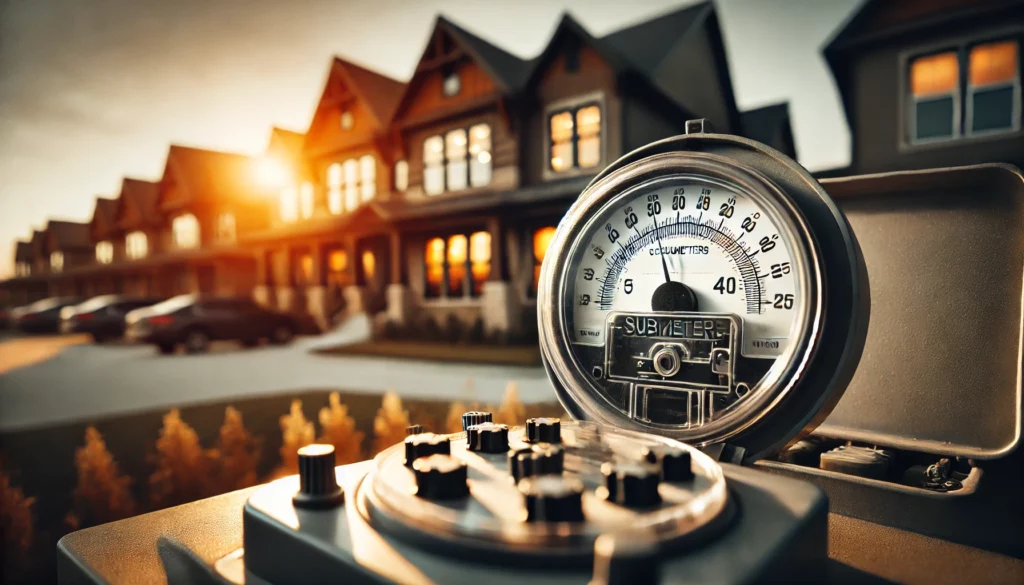Key Takeaways
Regular System Inspections and Calibration: Regular inspections and proper calibration of your submetering systems are crucial to ensure accurate and reliable performance.
Utilizing Advanced Software: Implementing advanced software for real-time data monitoring and automated reporting enhances efficiency and accuracy in managing submetering systems.
Effective Training and Documentation: Training your staff effectively and maintaining thorough documentation of all maintenance activities are essential for the smooth operation of submetering systems.

Maintaining Submetering Systems: Best Practices for Optimal Performance and Reliability
To maintain your submetering systems effectively, start with routine inspections to guarantee accuracy and compliance.
Calibrate measurement devices according to manufacturer guidelines and position them properly to avoid inaccuracies.
Schedule preventive maintenance based on system usage to catch issues early. Utilize advanced software for real-time data monitoring and automated reporting, which can enhance efficiency.
Always document maintenance activities and engage with tenants about their energy usage. Staying updated on regulations is essential, as it helps avoid compliance issues.
Explore additional strategies to optimize your submetering systems for better performance and reliability.
Regular System Inspections
Regular inspections of your submetering system are vital to confirm its accuracy and efficiency.
By routinely checking your system, you can identify potential issues before they escalate, saving you both time and money.
Start by reviewing the installation and configuration of your submeters to verify everything’s set up correctly.
Look for any signs of wear or damage, as even small issues can lead to significant inaccuracies in readings.
Next, check the connections and wiring to make sure they’re secure and free from corrosion. Loose or damaged connections can cause erratic measurements, impacting your ability to monitor usage effectively.
It’s also important to inspect the software used for data collection. Verify it’s up-to-date and functioning properly, as software glitches can compromise data integrity.
Don’t forget to document your findings during each inspection.
Keeping a log helps track any recurring problems and provides valuable insight into the system’s overall performance.
Calibrating Measurement Devices
Calibrating your measurement devices guarantees accurate readings, which is vital for effective submetering management.
Regular calibration assures that your devices measure electricity, water, or gas flow correctly, preventing discrepancies that could lead to incorrect billing or resource waste.
You should schedule calibrations based on the manufacturer’s recommendations, typically once a year or whenever you notice inconsistencies.
RELATED CONTENT
To begin, gather the necessary tools, such as calibration standards and equipment manuals. Follow the specific calibration procedures outlined for each device, as they can vary.
After calibration, always document the results to maintain a record of each device’s performance. This documentation is essential for audits and future reference.
If you find that a device consistently falls out of calibration, consider whether it’s due for replacement or if there’s an underlying issue affecting its accuracy.
Don’t forget that environmental factors can impact your devices.
Keep them in stable conditions, free from extreme temperatures or vibrations, to enhance their longevity and reliability.
Ensuring Proper Installation
When you’re setting up a submetering system, ensuring proper installation is essential.
You need to select qualified installers, position the equipment accurately, and comply with all relevant regulations.
Taking these steps will help you achieve reliable and efficient measurements.
Selecting Qualified Installers
Choosing qualified installers is essential for guaranteeing that your submetering system operates efficiently and accurately. The right professionals not only help in proper installation but also contribute to the longevity and reliability of your system.
Here are some key factors to evaluate when selecting installers:
- Experience: Look for installers with a proven track record in submetering systems to minimize risks.
- Certifications: Verify they’ve relevant certifications and training in handling the specific equipment you’re using.
- References: Ask for references or case studies to gauge their past performance and customer satisfaction.
- Knowledge of Local Codes: Qualified installers should be familiar with local regulations and codes to ensure compliance and avoid future issues.
Accurate Equipment Placement
Accurate equipment placement is essential for guaranteeing your submetering system delivers precise measurements and reliable performance. When you install submeters, you need to evaluate several factors to maximize accuracy.
First, verify that the submeter is positioned in a location where flow conditions are stable, away from bends, valves, and other obstructions that can disrupt the flow of water or energy.
Next, pay attention to the height of the submeter. Installing it at the manufacturer’s recommended height can prevent air pockets, which might skew readings. Additionally, make sure the equipment is level; an uneven installation can lead to inaccurate measurements.
It’s also important to account for environmental factors. Avoid placing your equipment in areas exposed to extreme temperatures, moisture, or direct sunlight, as these conditions can affect performance.
Compliance With Regulations
Guaranteeing compliance with regulations is essential for the proper installation of submetering systems, as it not only assures accuracy but also protects you from potential legal issues. When you prioritize adherence to local and national codes, you help guarantee that your system functions effectively and meets all requirements.
To achieve compliance, consider the following best practices:
- Research Local Regulations: Understand the specific codes that apply to your area, as they can vary greatly.
- Choose Certified Equipment: Use devices that meet established standards and have been tested for accuracy and reliability.
- Hire Qualified Professionals: Verify that installation is performed by licensed electricians or certified technicians familiar with submetering systems.
- Regular Inspections: Schedule routine inspections to confirm that your system continues to meet compliance standards over time.
Monitoring Data Accuracy
Regularly checking your submetering system’s data is essential for identifying discrepancies and guaranteeing reliable performance.
By keeping a close eye on the data, you can spot errors that might arise from faulty meters or incorrect readings. Start by establishing a routine for data verification.
This could involve cross-referencing your submeter readings with utility bills or other reliable sources.
Next, use software tools designed for data analysis. These tools can help automate the process, making it easier to track patterns and pinpoint anomalies.
Don’t forget to train your team on the importance of data accuracy.
When everyone understands how to recognize and report issues, you’ll improve the system’s overall reliability.
Additionally, consider implementing regular audits of your submetering data.
These audits can reveal long-term trends that might indicate a need for recalibration or replacement of equipment.
Finally, maintain clear documentation of all data checks and anomalies.
This record will help you identify recurring issues and inform future decisions about maintenance and upgrades.
Scheduling Preventive Maintenance
To keep your submetering systems running smoothly, you need to establish regular maintenance intervals.
Documenting these activities is vital for tracking performance and identifying potential issues early.
Establish Regular Intervals
Scheduling preventive maintenance at consistent intervals keeps your submetering systems running smoothly and helps prevent costly issues.
Regular maintenance allows you to identify and address minor problems before they escalate into major failures, ensuring your systems operate efficiently.
Here are some best practices for establishing those intervals:
- Assess System Usage: Consider how often your submetering systems are used to determine the frequency of maintenance.
- Manufacturer Recommendations: Always refer to the manufacturer’s guidelines for maintenance schedules, as they provide valuable insights specific to your equipment.
- Historical Data Review: Examine past maintenance records to identify patterns or recurring issues that may require more frequent attention.
- Environmental Factors: Take into account the environment where your systems operate; harsher conditions may necessitate more frequent maintenance.
Document Maintenance Activities
Documenting maintenance activities guarantees you keep track of what’s been done and helps identify trends or areas needing improvement.
By scheduling preventive maintenance, you make sure that your submetering systems operate efficiently and reduce the risk of costly failures.
Start by creating a detailed log of all maintenance tasks performed, including dates, specific activities, and any issues encountered.
Use a calendar or software tool to set reminders for upcoming maintenance tasks.
Regularly review this log to spot patterns—like recurring issues with specific equipment—which can guide your future maintenance strategies.
This proactive approach not only saves time but can also extend the lifespan of your systems.
Don’t forget to involve your team in this process. Encourage them to report any unusual readings or malfunctions immediately.
This way, you’ll catch potential problems early, and your documentation will reflect real-time conditions.
Training Staff Effectively
Effective training for staff guarantees they understand the nuances of submetering systems and can operate them efficiently. When your team is well-trained, they can identify issues quickly, maintain accuracy, and enhance overall performance.
Here are some best practices to contemplate when training your staff:
- Hands-On Training: Allow staff to engage directly with the submetering systems. This practical experience helps reinforce theoretical knowledge.
- Regular Workshops: Schedule periodic training sessions to cover updates, new technologies, and system changes. This keeps everyone informed and capable.
- Create Manuals and Guides: Develop clear, concise documentation that staff can refer to when in doubt. Visual aids and step-by-step instructions can be particularly helpful.
- Encourage Questions: Foster an environment where staff feel comfortable asking questions. This open dialogue can clarify uncertainties and deepen understanding.
Utilizing Advanced Software
When you utilize advanced software in your submetering systems, you release significant integration benefits that streamline operations.
Real-time data monitoring allows you to make informed decisions quickly, while automated reporting features save you valuable time.
Embracing these tools can enhance your efficiency and accuracy in managing resources.
Software Integration Benefits
Integrating advanced software into your submetering systems can greatly enhance data accuracy and streamline management processes.
Here are some key benefits you’ll experience:
- Improved Data Collection: Advanced software automates data gathering, reducing manual errors and ensuring reliable readings.
- Centralized Reporting: You’ll have access to thorough reports, making it easier to analyze trends and performance metrics in one location.
- Enhanced User Interface: Modern software solutions offer intuitive dashboards that simplify navigation and make it easier for you to monitor your systems.
- Seamless Integration: These systems can often connect with existing infrastructure, allowing for a smoother changeover and minimizing disruptions.
Real-Time Data Monitoring
Real-time data monitoring takes the advantages of advanced software a step further, allowing you to track energy usage and system performance instantaneously.
With this technology, you can see how much energy each unit consumes at any given moment, helping you identify trends and anomalies quickly.
This immediate access to data empowers you to make informed decisions about energy management and operational efficiency.
For instance, if an unusual spike in usage occurs, you can investigate right away, potentially saving costs and identifying issues before they escalate.
Moreover, real-time monitoring enhances your ability to engage tenants or stakeholders by providing them with accurate information about their energy consumption.
You can share insights and encourage energy-saving practices, fostering a culture of sustainability within your building or community.
Utilizing advanced software for real-time monitoring also streamlines your maintenance efforts.
When you can see performance data live, you can schedule maintenance proactively, rather than reactively, reducing downtime and extending the life of your submetering systems.
Essentially, real-time data monitoring is vital for optimizing both performance and sustainability in submetering systems.
Automated Reporting Features
Automated reporting features simplify your energy management by generating detailed usage reports without manual input.
This advanced software not only saves you time but also enhances accuracy in your submetering systems.
With these tools, you can easily track energy consumption, identify trends, and make informed decisions to optimize your operations.
Here are some key benefits of utilizing automated reporting features:
- Time Efficiency: Generate reports in a matter of seconds, allowing you to focus on analysis rather than data collection.
- Enhanced Accuracy: Reduce human error by relying on automated data capture, ensuring more reliable reporting.
- Customizable Reports: Tailor reports to fit your specific needs, whether it’s daily, weekly, or monthly usage data.
- Real-Time Insights: Access up-to-date information that helps you quickly identify and address potential issues.
Addressing Tenant Concerns
Addressing tenant concerns about submetering systems is crucial for fostering trust and ensuring a positive living experience.
When you introduce submetering, it’s important to communicate clearly about how it works and its benefits. Many tenants worry about accuracy and fairness.
By providing transparent information about measurement methods and billing processes, you can alleviate these concerns.
Encourage open dialogue by hosting Q&A sessions or providing informational materials. This gives tenants a platform to voice their questions and express worries.
You might also consider offering a dedicated contact person for submetering inquiries, making it easier for tenants to get the information they need.
Additionally, address privacy concerns head-on. Assure tenants that their data will be handled securely and used solely for billing purposes.
If there are any changes to how data is collected or used, communicate these changes promptly.
Implementing Energy Audits
Implementing energy audits can greatly enhance the efficiency of your submetering systems by identifying areas where energy consumption can be reduced.
Regular audits allow you to assess how energy is used across your facilities and pinpoint inefficiencies that could be costing you money.
Here are some key steps to take into account when conducting energy audits:
- Establish a baseline: Gather historical energy usage data to understand your current consumption patterns.
- Identify high-consumption areas: Focus on areas with the highest energy usage to target improvements effectively.
- Evaluate equipment performance: Inspect HVAC systems, lighting, and appliances to make sure they’re operating at peak efficiency.
- Analyze tenant behaviors: Look into how occupants interact with energy-consuming devices and identify opportunities for education and engagement.
Keeping up With Regulations
Regular energy audits not only help you identify inefficiencies but also keep you informed about the ever-changing regulations governing submetering systems.
Staying compliant with these regulations is essential to avoid fines and guarantee your system operates smoothly.
To keep up with regulations, make it a habit to review local, state, and federal guidelines regularly.
These laws can differ greatly based on your location or the specific type of submetering system you’re using.
Engaging with industry associations or subscribing to relevant newsletters can keep you updated on any changes that may affect your operations.
Additionally, consider working with a compliance consultant who specializes in submetering systems.
They can provide invaluable insights and help you navigate the complex regulatory landscape.
Optimizing Submetering Systems for Long-Term Success
Implementing best practices for maintaining submetering systems is essential to ensure their accuracy, efficiency, and longevity.
By adhering to regular inspections, proper calibration, effective training, and leveraging advanced software, you can significantly enhance the performance of your submetering systems.
These strategies not only help prevent costly errors and compliance issues but also foster a transparent and trustworthy environment for your tenants.
Keeping up with regulations and conducting regular energy audits further ensure that your system remains up-to-date and operates within legal requirements.
Embrace these best practices to optimize your submetering systems, ensuring reliable and accurate energy management for your properties.
No related posts.





















